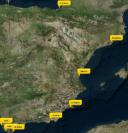











Our Journey: 2015
Cartagena: (11-13 July 2015)

After having followed miles of Spanish coast covered in concrete apartment blocks or large fields of greenhouses, we stopped in Cartagena. Finally, a city that has something interesting to
fields of greenhouses, we stopped in Cartagena. Finally, a city that has something interesting to offer . The harbor of Cartagena is located in a well protected bay and the hills at the entrance
offer . The harbor of Cartagena is located in a well protected bay and the hills at the entrance are covered in old fortresses. No doubt this harbour has a rich history due to its unique location
are covered in old fortresses. No doubt this harbour has a rich history due to its unique location and good protection from bad weather. In fact the harbor of Cartagena was already being used in
and good protection from bad weather. In fact the harbor of Cartagena was already being used in the early centuries AD. It is no surprise that inside the city there are numerous archeological
the early centuries AD. It is no surprise that inside the city there are numerous archeological places dating from the Roman Empire. Today, nobody wants to start building in Cartagena because
places dating from the Roman Empire. Today, nobody wants to start building in Cartagena because if during the construction you find any historical artifacts you have to call the archeologist who
if during the construction you find any historical artifacts you have to call the archeologist who may delay your project or simply cancel it because of the historical value of the finding. We
may delay your project or simply cancel it because of the historical value of the finding. We visited a roman theatre as well as the public baths. We learned during our visit that this place
visited a roman theatre as well as the public baths. We learned during our visit that this place was very important because a lot of deals were made nearby. Next to the baths you had several
was very important because a lot of deals were made nearby. Next to the baths you had several meeting rooms and often banquets were organized.
meeting rooms and often banquets were organized.
 Nearby, an archeologist opened a door and gave us access to a Roman road located under a
Nearby, an archeologist opened a door and gave us access to a Roman road located under a building. We could see traces of the wheels on the pavement. The archeologist told us that
building. We could see traces of the wheels on the pavement. The archeologist told us that nearby there were a lot of artifacts from other periods, such as the Byzantine.Today the city is
nearby there were a lot of artifacts from other periods, such as the Byzantine.Today the city is full of 4 and 5 floor buildings that were build soon after the war, at a time when archaeology was
full of 4 and 5 floor buildings that were build soon after the war, at a time when archaeology was not important.
not important. 
 The city also has an interesting underwater archaeology museum where the whole process of
The city also has an interesting underwater archaeology museum where the whole process of discovery and protection of wrecks is explained. Often, once the archaeologists have finished
discovery and protection of wrecks is explained. Often, once the archaeologists have finished inventorying a wreck, they will bury it in sand and protect it with a cage for future generations.
inventorying a wreck, they will bury it in sand and protect it with a cage for future generations. Only a few wrecks are brought to the surface because of the cost involved. Catagena is also a big
Only a few wrecks are brought to the surface because of the cost involved. Catagena is also a big military base of the Spanish army including a submarine base. However, today the major activity
military base of the Spanish army including a submarine base. However, today the major activity in Cartagena is the loading of ships with ores. Containers are also handled in this harbour.
in Cartagena is the loading of ships with ores. Containers are also handled in this harbour.
 fields of greenhouses, we stopped in Cartagena. Finally, a city that has something interesting to
fields of greenhouses, we stopped in Cartagena. Finally, a city that has something interesting to offer . The harbor of Cartagena is located in a well protected bay and the hills at the entrance
offer . The harbor of Cartagena is located in a well protected bay and the hills at the entrance are covered in old fortresses. No doubt this harbour has a rich history due to its unique location
are covered in old fortresses. No doubt this harbour has a rich history due to its unique location and good protection from bad weather. In fact the harbor of Cartagena was already being used in
and good protection from bad weather. In fact the harbor of Cartagena was already being used in the early centuries AD. It is no surprise that inside the city there are numerous archeological
the early centuries AD. It is no surprise that inside the city there are numerous archeological places dating from the Roman Empire. Today, nobody wants to start building in Cartagena because
places dating from the Roman Empire. Today, nobody wants to start building in Cartagena because if during the construction you find any historical artifacts you have to call the archeologist who
if during the construction you find any historical artifacts you have to call the archeologist who may delay your project or simply cancel it because of the historical value of the finding. We
may delay your project or simply cancel it because of the historical value of the finding. We visited a roman theatre as well as the public baths. We learned during our visit that this place
visited a roman theatre as well as the public baths. We learned during our visit that this place was very important because a lot of deals were made nearby. Next to the baths you had several
was very important because a lot of deals were made nearby. Next to the baths you had several meeting rooms and often banquets were organized.
meeting rooms and often banquets were organized.
 Nearby, an archeologist opened a door and gave us access to a Roman road located under a
Nearby, an archeologist opened a door and gave us access to a Roman road located under a building. We could see traces of the wheels on the pavement. The archeologist told us that
building. We could see traces of the wheels on the pavement. The archeologist told us that nearby there were a lot of artifacts from other periods, such as the Byzantine.Today the city is
nearby there were a lot of artifacts from other periods, such as the Byzantine.Today the city is full of 4 and 5 floor buildings that were build soon after the war, at a time when archaeology was
full of 4 and 5 floor buildings that were build soon after the war, at a time when archaeology was not important.
not important. 
 The city also has an interesting underwater archaeology museum where the whole process of
The city also has an interesting underwater archaeology museum where the whole process of discovery and protection of wrecks is explained. Often, once the archaeologists have finished
discovery and protection of wrecks is explained. Often, once the archaeologists have finished inventorying a wreck, they will bury it in sand and protect it with a cage for future generations.
inventorying a wreck, they will bury it in sand and protect it with a cage for future generations. Only a few wrecks are brought to the surface because of the cost involved. Catagena is also a big
Only a few wrecks are brought to the surface because of the cost involved. Catagena is also a big military base of the Spanish army including a submarine base. However, today the major activity
military base of the Spanish army including a submarine base. However, today the major activity in Cartagena is the loading of ships with ores. Containers are also handled in this harbour.
in Cartagena is the loading of ships with ores. Containers are also handled in this harbour.

























